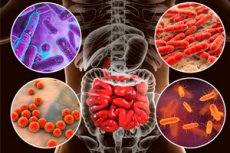New publications
Targeting the gut microbiome: a new approach to diabetes management
Last reviewed: 02.07.2025

All iLive content is medically reviewed or fact checked to ensure as much factual accuracy as possible.
We have strict sourcing guidelines and only link to reputable media sites, academic research institutions and, whenever possible, medically peer reviewed studies. Note that the numbers in parentheses ([1], [2], etc.) are clickable links to these studies.
If you feel that any of our content is inaccurate, out-of-date, or otherwise questionable, please select it and press Ctrl + Enter.

A recent study published in the journal Nutrients examines the key role of gut microbiota in the pathogenesis and management of diabetes mellitus (DM).
The Role of the Gut Microbiome in Diabetes
Previous studies have shown that type 2 diabetes mellitus (T2DM) may be associated with certain changes in the composition of the gut microbiota. Specifically, patients with T2DM were found to have lower levels of Firmicutes and Clostridia bacteria compared to controls.
Positive correlations were also noted between the Bacteroides-Prevotella to C. coccoides-E. rectale and Bacteroidetes to Firmicutes ratios and plasma glucose concentrations. T2DM patients had more Betaproteobacteria, which positively correlated with decreased glucose tolerance.
A metagenome-wide association study (MGWAS) in China reported microbial dysbiosis in patients with T2DM. Certain pathogens such as Clostridium hathewayi, Bacteroides caccae, Eggerthella lenta, Clostridium ramosum, Clostridium symbiosum, and Escherichia coli were found in the gut of these patients.
There was also a significant reduction in butyrate-producing bacteria such as Faecalibacterium prausnitzii, Clostridiales sp. SS3/4, E. rectale, Roseburia inulinivorans, and Roseburia intestinalis. The gut microbiome of T2D patients also had more mucus-degrading and sulfate-reducing species.
A study in European women with T2DM confirmed decreased levels of Faecalibacterium prausnitzii and Roseburia intestinalis. A decrease in five Clostridium species and an increase in four Lactobacillus species were also found.
Correlations between Clostridium and glycosylated hemoglobin (HbA1c), C-peptide, plasma triglycerides, and insulin were negative, whereas HbA1c was positively correlated with Lactobacillus levels. These data suggest an association of these microbial species with the development of T2DM.
Dysbiosis influences the pathogenesis of T2DM through various molecular mechanisms. For example, gut microbiota can influence lipid and glucose metabolism, which in turn influences the development of T2DM. These effects may be mediated by important regulators such as bile acids, branched chain amino acids (BCAAs), short chain fatty acids (SCFAs), and bacterial lipopolysaccharides (LPS).
Gut microbiota as a therapeutic target for diabetes treatment
Probiotics improve glycemic control and insulin sensitivity, especially among diabetics and those at risk for diabetes.
Some bacterial strains, such as Lactobacillus acidophilus and Bifidobacterium bifidum, exert positive effects on various metabolic processes. One of the key mechanisms of action is the interaction of SCFAs with G protein-coupled receptors, which improves insulin sensitivity. Therapeutic strategies aimed at activating sirtuin 1 (SIRT1) have also shown promising results in improving insulin sensitivity and glycemic control in diabetics.
Fetuin-A, a protein produced by the liver, can inhibit insulin signaling, and elevated levels are associated with insulin resistance and increased inflammation. A randomized controlled trial found that supplementation with Lactobacillus casei for eight weeks reduced fetuin-A levels, increased SIRT1, and improved insulin resistance and insulin and postprandial glucose levels. L. casei also has anti-inflammatory properties, as evidenced by reduced levels of inflammatory markers such as C-reactive protein (CRP) and tumor necrosis factor α (TNF-α) following L. casei supplementation.
Synbiotics, combinations of probiotics and prebiotics, also offer a promising approach to treating diabetes. A study in diabetics undergoing hemodialysis found that synbiotic supplements significantly reduced insulin concentrations, fasting glucose levels, and insulin resistance while increasing insulin sensitivity.
Faecal microbial transplantation (FMT), which involves transplanting faecal bacteria from a healthy individual to another individual, has been studied for the treatment of T2DM. One study found that FMT, either alone or in combination with metformin, resulted in significant improvements in key clinical measures in patients with T2DM, including reductions in body mass index (BMI), pre- and post-meal glucose levels, and HbA1c concentrations.
Diet and exercise can also significantly influence the composition of the gut microbiota. Whole grain and fiber-rich diets support a favorable and diverse microbial environment, leading to the production of SCFAs, which can reduce inflammation and improve insulin sensitivity.
Regular exercise also has a positive effect on the gut microbiota, helping to better regulate blood glucose levels. Mouse models have shown that exercise leads to the production of SCFAs and restores gut health.
The results of the review indicate that the mechanism of microbiota dysbiosis may be a potential factor in the pathogenesis of T2DM, representing new treatment options targeting the microbiota. To develop more personalized medical interventions, more research is needed to better understand the role of gut microbiota disruption in the pathogenesis and progression of T2DM.
